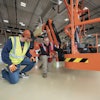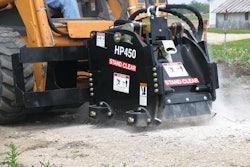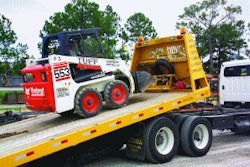At the height of the season many contractors can get visits from an “old friend,” the “Time Waster.” While Time Wasters often camouflage their efforts, sneaking up on a contractor before setting their trap, Time Wasters are a constant source of frustration requiring a persistence to overcome.
Consider how much time each day your crews are simply waiting. What are the causes for such waiting? Let’s examine a few causes, calculate a possible cost for the waiting, then provide a few proven corrective efforts that can help reduce, if not eliminate, some of your more impactful Time Wasters.
Time Waster Causes
- Equipment breakdown
- Employees late to work
- Gassing up vehicles/Putting water in roller
- Late delivery of pre-arranged materials
- Jobsite not accessible or prepared
- Owner didn’t unlock premises
- Owner forgot to inform employees “not to park”
- Supply inventory empty
- Employee forgot important tool or equipment
- No directions available to jobsite
- Crew waiting for supervisor to return from lunch
What are the costs associated with having workers waiting around? Let’s take a look at one situation. Consider a paving contractor who suddenly finds his six-person crew without hot mix asphalt. There was a mix-up in the directions given to the driver and the crew is standing around for one hour before the material shows up. Let’s calculate the possible costs incurred by the contractor having six workers standing around for one hour.
6 Workers x 1 Hour Waiting = 6 Total Worker-Hours Spent Waiting
If Average Hourly Rate = $30/Hour (Fully Burdened Rate)
6 Worker Hours x $30/Hour = $180
So, the cost for having labor waiting on materials is $180. Are there other costs? Probably, but they might be lessened depending on what other parts of the project can be worked on before the material truck arrives. Also, if the crew needed this delayed material to finish out a section then the hour wait might cause there to be visible seam between the previous pad and the soon-to-be-finished section.
You might think that one mistake costing $180 is no big deal. And you’re right, if this only happened once in a while. Unfortunately, problems like this can shift for one reason or another, leaving employees waiting around for five minutes here and 15 minutes there. But if the project was priced to have made about $800 - $1,500 profit, pulling another $180 from the profit just increases the pressure to make more money on another project.
Needless to say, we can only imagine what all of the waiting around is robbing from our organization during the course of a year. Contractors must do a better job of not only providing clearer direction and instruction but also involving workers in learning how to determine direction for themselves.
Consider some contractor-tested tips to reduce the amount time your workers are wastefully waiting.
- Require Weekly “Look Ahead” Schedule & Crew Huddles. “Come on man!” Take the gloves off and make weekly scheduling (a “look ahead”) and crew huddles mandatory. Our project scheduling and customer expectations are just too critical not to have a weekly plan and then a morning and afternoon “stand-up meeting” (crew huddle) in place. Between these two proven tips you can reduce planning-related time-wasting events by 30% - 40%.
- Make Important Telephone Numbers Available. Contractors and their supervisors should not be the only employees with critical telephone numbers. A laminated card of all-important numbers can be provided to each employee or copies can be attached to each company vehicle. Not having the correct telephone numbers when they are needed adds to the time-wasted experienced. This is the easiest tool to use, and it should be updated monthly, quarterly or at least annually.
- Job Cost & Track Performance. There is no excuse for any contractor, of any size, to not monitor performance and costs associated with each job. I have found the larger the contractor the more likely that he will track productivity and then conduct job-costing “debriefs” with those involved with the project. The secret here is to make this a consistent effort and use the information to determine “what are we doing right” and “what needs to improve or change.”
- Create Job Tools & Materials List. This document should be completed for every job and it should itemize every tool and material needed to complete the work. I’ve seen contractors include this on the backside of their Look Ahead schedule.
- Make Preventive Maintenance a Company Priority. Equipment that runs without breaking down will mean more profits and happier employees. The machine or truck that breaks down every other week tends to emotionally and physically wear out the employees, casting doubt in their minds about your commitment to help them work without problems. Put all your equipment and vehicles on a preventive maintenance schedule and watch how much more work you see getting done… on time.
- “Stage” Your Jobsite at the End of Each Day. This tip is a real time saver. Do you need diesel in the vehicle before starting up again tomorrow? Fill up the tank before calling it quits today. Need hand tools and striping equipment loaded on your trailer before pulling out of your shop in the morning? Load it tonight before you send the troops home. Getting the job or worksite ready for the next day’s performance will save you time the following morning and warn you if you are missing anything. If you’re short anything you still have the evening to pull the needed items together before beginning the next morning.
- Conduct Weekly Project/Schedule Update. This should include all of your laborers, not just the leaders, but no matter who you include this meeting should look at what the schedule includes, tough upcoming jobs, jobs with different needs, safety reminders, high maintenance clients etc. This meeting can address technical issues but it also helps to build teamwork. It keeps people informed, something that many contractors often are accused of not doing very well.
For the most part, the techniques presented in this article are common sense, but integrating these techniques into your own leadership will reduce wasted time among your crews and direct more dollars directly to your bottom line.
Brad Humphrey is president and founder of Pinnacle Development Group. To find out more about Brad and his company visit www.pinnacledg.com or e-mail [email protected]. Also, become a TCBF Member by going to www.thecontractorsbestfriend.com and receive an educational article from Brad every Wednesday.



















